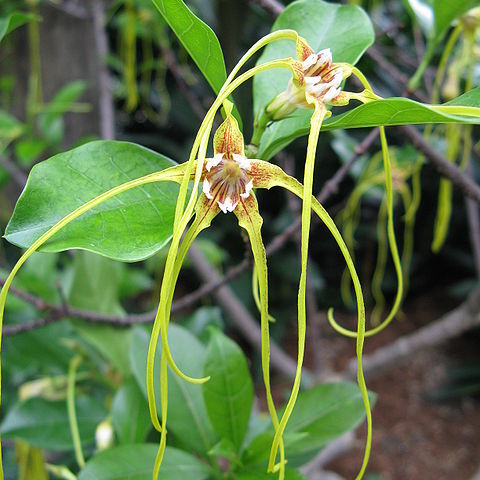Lianas or sarmentose shrubs, stolon bearing when pruned, to 4.5 m tall, glabrous except for corolla, latex clear or yellowish. Trunk to 4 cm in diam.; branches dark gray, densely lenticellate, branchlets reddish brown. Petiole 5-10 mm; leaf blade elliptic or slightly obovate, 3-10 X 1.5-5 cm; lateral veins 4-9 pairs. Cymes 3-15-flowered; peduncle to 1.5 cm; bracts linear or narrowly ovate, deciduous. Pedicel to 1 cm. Sepals narrowly triangular, 4-11 mm. Corolla yellow, tube 0.9-1.6 cm, puberulent on both sides or glabrous inside; lobes with a red basal spot inside, ovate, to 10 cm, abruptly narrowed into pendulous tails to 1 mm wide; corona lobes 10, greenish yellow, triangular or awl-shaped, 0.9-3 mm. Anthers included, connective tail to 0.6 mm. Ovary glabrous. Follicles ellipsoid-oblong, 9-15 X 2-3.5 cm, hard, woody, divergent at 180-250°. Seeds fusiform, 1.3-2 cm, beak 1.2-3.4 cm, coma 3.5-5.5 cm. Fl. Mar-Jul. 2n = 18.
More
A woody climber or shrub. When it is pruned it produces stolons. It grows 4.5 m tall. The trunk can be 4 cm across. The leaves are 3-10 cm long by 205 cm wide. There are 3-15 flowers in a group. They have a yellow tube. The fruit are follicles 9-15 cm long by 2-4 cm wide. They are hard and woody.

